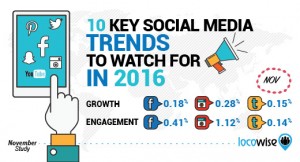
Display ads are a great tool for advertisers. They’re visually engaging, and they boost brand awareness and trust with consumers. And when display ads are used for remarketing/retargeting, they increase the odds for conversions, too.
Advertisers employ an array of different visual display options ranging from static banners to video, each with the ability to be optimized for desktop, mobile, and video platforms.To ensure your display ads receive optimal views by the right audience, you’ll need to refine your targeting.
Here are five ways to effectively target your display advertising campaign.
1. Demographic Targeting
Make sure your display ad reaches the right audience by employing demographic targeting. Demographic targeting enables you to filter your audience by a variety of criteria including:
- Age.
- Gender.
- Marital status.
- Income.
- Job.
By using specific constraints, your display ad will only reach relevant consumers, the ones more likely to buy your product.
Keep in mind that depending on the type of product you’re selling, you may also have to hypertarget your desired demographic, or potentially face backlash like Bugaboo encountered.

Source: Today
Bugaboo sells strollers, so their target demographic is moms. However, Bugaboo is a high-end stroller company, favored by celebrity moms. Products and ads geared toward celebrities don’t always successfully translate to the average consumer.
Bugaboo received criticism from several non-celeb moms over a Facebook display ad for the “Runner” stroller. The ad featured an athletic woman, dressed in a bikini and running shoes, using her stroller to jog.
Some moms took offense, citing the ad as unrealistic. Some even made snarky remarks such as “I often jog in my bikini.” Well, jogging in your bikini may be a common occurrence in Beverly Hills, but definitely not in Smalltown, USA. Here, Bugaboo missed the boat and failed to connect to their hyper specific target audience (e.g. wealthy athletic moms) because their demographic was too general.
On the flip side, be careful you don’t get too specific with your targeted demographic (e.g. 22-year-old athletic moms). You could end up excluding a huge chunk of converting clicks (e.g. athletic moms in their twenties, early thirties). Keep your target audience in mind, but find a happy medium for parameters.
Demographic Targeting Tip: Know your audience and their needs so you can determine how deep your demographic targeting needs to go.
2. Geotargeting
Geotargeting comes into play when you want to target consumers within a specific area. Perhaps you’re a local hair salon looking to drum up local business. Use geotargeting to hone in on a particular radius (e.g. within 25 miles of Middletown, DE).
If you own a franchise of hair salons within the tri-state area, you can use geotargeting to target more than one area (e.g. Newark; West Chester, PA; and Baltimore, MD). Depending on whether business is slower in say Newark versus Baltimore, you can adjust your bids accordingly, too.
For your mobile display ads, geotargeting will help you reach those on-the-go consumers within your area. Here, Sally’s Cupcakes geotargets mobile users on smartphones and tablets.

Source: Cravelabs
If I see this ad on my smartphone, and work within two-miles from Sally’s, the likelihood of me going there to purchase a cupcake on my lunch break increases significantly. In contrast, if Sally’s didn’t use geotargeting and their mobile display ad ran on the opposite side of the country, well, that’s just wasted time and money on Sally’s part.
Geotargeting Tip: Use geotargeting to target consumers within a set radius.
3. Dayparting
Demographic targeting and geotargeting are great tools, but they’re only a part of the targeting puzzle. What happens if your display ads are running when customers aren’t online or your business isn’t open? How do you fix that targeting issue? The solution: dayparting.
Dayparting allows you to schedule your ads to mirror consumer behaviors, business hours, and even seasons or special events (e.g. back-to-school season or daylight savings time).
For instance, the hair salon can have their ads run during their business hours of 8 a.m. to 7 p.m. Monday through Saturday. This prevents consumers from seeing the ad at 8 p.m., and attempting to call after hours to schedule an appointment. And companies like Sally’s Cupcakes who want to capture their audience’s attention for specific events (e.g. National Cupcake Day) will benefit from dayparting, too.
A great example of dayparting in action is Saint Francis Hospital’s desktop banner ad, which gives thanks to physicians on National Doctors’ Day.

Here, dayparting ensures the banner ad will only run on March 30, which is National Doctors’ Day. After the 30th, the banner will be removed since the event has passed.
In the meantime, Saint Francis is banking on consumers noticing the banner ad, wanting to know more about National Doctors’ Day, and clicking on it. If they do, they’ll be taken to this landing page. And St. Francis may just score some new patients.

Dayparting Targeting Tip: Hit while the iron is hot and target your audience at the right time.
4. Behavioral/Category Targeting
More often than not, consumers don’t bite right out the gate: you have to retarget. Display ads are a great way to provide a visual reminder of your product. Consumers will be like, “Oh yeah, I forgot I wanted that pair of shoes…” Hopefully, that bread crumb reminder entices them to click and make a purchase.
Behavioral targeting shows targeted ads to consumers based on their browsing behavior. By using category targeting, you can select specific categories or topics relevant to your audience personas to collect data based on consumers’ browsing habits and purchases.
For instance, I’m an avid Sephora shopper and most likely part of their list-based retargeting. Anytime I go to Sephora’s website, items I’ve abandoned in my shopping cart later appear in my Facebook newsfeed as display ads. Sometimes I’ll even get a sponsored display video ad like this one from Philosophy.

What’s interesting is I requested this particular Philosophy sample from Sephora, not Philosophy. Here, it could be a case of Sephora sharing data with Philosophy. Maybe it’s Sephora’s tactile way of being not so obvious that they’re retargeting me, or it’s possible I visited Philosophy a while back and they’re just now coincidentally retargeting me.
Here’s a little trick. Whenever I’m curious why a sponsored ad is appearing in my newsfeed, I can simply click on the arrow in the upper right-hand corner, then click “Why am I seeing this?” Boom. Mystery solved.

How Philosophy is getting my info brings up an important point. While collecting this data is helpful to marketers (especially for retargeting), some consumers don’t like the feeling that their every move is being watched. Consumers who wish to opt-out can do so at anytime so long as it’s a participating company. Here, Chevy includes a ‘Forward I’ icon in their display ad, which allows customers can click to opt-out.

Consider making your company an opt-out one, too.
Behavioral/Category Targeting Tip: Use consumers’ browsing habits and purchase history to deliver ads relevant to them. But also be fair and give them the option to opt-out.
5. Language Targeting
Once you’ve set your demographic, dayparting, geotargeting, and behavioral/category targeting, you’ve pretty much got all of your bases covered.
Except for one last thing: language targeting!
All of that display advertising targeting is no good if your audience isn’t fluent in the language.
Language targeting is a great tool for areas with diverse populations. For instance, let’s say you’re a wholesale retailer for soft drink products, and you’re targeting Spanish restaurants. Here, you simply refine your campaign by going to languages and selecting Spanish as your language.

Source: PMG
Or if you need to target more than one language, you can select English, Spanish, Chinese, and so on.

Source: PMG
It’s important to note that a Spanish speaker will already have their interface settings set to Spanish, so once you switch your language setting over, you’ll be good-to-go.
Language targeting not only is important in regular display ads, but in video ads, too. Many brands are employing interactive video ads, especially as pre-roll on YouTube to reach consumers. If your video ad is targeting Spanish speakers, but the viewer only speaks English, naturally the message will be lost in translation.
Language Targeting Tip: Make sure your language targeting matches your target audience’s interface language.
Digital & Social Articles on Business 2 Community(52)







